No other contemporary director has produced a body of work as sensual, radical and feverishly hypnotic as that of Thai artist and filmmaker Apichatpong Weerasethakul. His shape-shifting cinema, which blends elements of Thai pop culture, folklore, the supernatural and science fiction, is restlessly experimental and boldly idiosyncratic. But it is also imbued with great tenderness and warm humour, acutely alert to the possibilities of relationships to heal and expand our consciousness.
A beautiful soldier woos a shy young man who later transforms into a mythical creature. A monk who once dreamed of being a DJ strikes up a friendship with a dentist who likes to croon. A family gathered at dinner is visited by two long-dead relatives, one of whom has become a monkey with glowing eyes. And a young woman’s body becomes temporary host to the spirit of a soldier afflicted with a strange sleeping sickness.
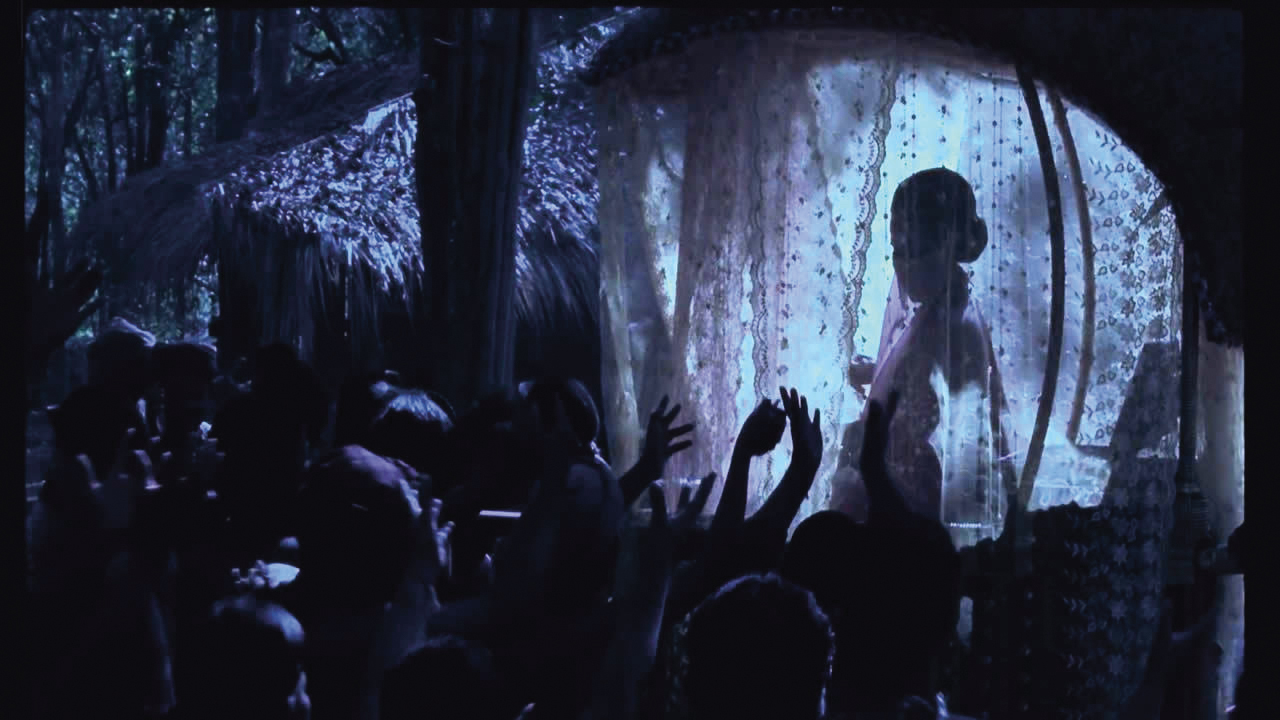
Uncle Boonmee Who Can Recall His Past Lives, 2010
Courtesy film still: Kick the Machine Films, Bangkok
The stories may be extravagantly imaginative, but the treatment is low-key, bordering on deadpan. Even when the imagery is hallucinatory, the leisurely rhythms and elliptical narratives inspire a state of dreamlike calm in the viewer. This is crucial because it’s part of what makes the films so subversive. They ease us into an alternate worldview, allowing us to acclimatize slowly to this new environment. Before long, we awaken to a place where borders – those dividing the living and the dead, human from animal, dream from reality – cease to exist in any recognizable form.
In Apichatpong’s cinema, there is no ‘other’. There are no heroes or villains. For him, daily life holds great mystery and drama, and his filmmaking process often involves blurring the line between life and art. It’s an extension of his being in the world, and in a pragmatic sense, it’s a way to spend time with others. For his feature Mysterious Object at Noon (2000), he and his crew travelled Thailand’s countryside, interviewing people and collecting tales both real and imagined. It’s a film about storytelling as both a collective and personal endeavour, but it is also a film about connecting with strangers.
Perhaps no relationship is more important than his intimate friendship with Jenjira Pongpas. Over the course of five features and nearly fifteen years, we witness their relationship evolve onscreen, and her transformation from an untrained actress into an unlikely star. Central to their relationship is Jenjira’s connection to the rural northeast of Thailand. A generation older than Apichatpong, she witnessed first-hand the violent anti-communist military campaigns of the 1960s and 1970s. The region and its history became the primary subject of Primitive, his large-scale multi-platform project that opened at the Tate Modern in 2009, and served as the backdrop for Uncle Boonmee Who Recalls His Past Lives, the director’s breakthrough and the first Southeast Asian film to win the Palm d’Or at Cannes in 2010.
For Apichatpong, light – both as medium and as metaphor – is a potent force. It has the power to reveal and to conceal. In his 2015 feature Cemetery of Splendor and related video installation Fireworks (Archive), he explores relationships between light and political memory. In the former, soldiers are hooked up to glowing tubes in a clinic and dream of ancient wars and traumas, while in the latter, camera flashes light a nocturnal tour of a sculpture garden filled with menacing creatures. Both exemplify Apichatpong’s ability to simultaneously soothe and unsettle us, to lull us into a state of heightened awareness.

Blissfully Yours, 2002 follows a young Thai woman and her taciturn Burmese boyfriend, an illegal immigrant in need of a forged ID, as they venture out to the countryside for a bucolic idyll punctuated by matter-of-fact sexual interludes.
Composed of meditative long takes, the film is casually erotic, playful – the opening credits appear 45 minutes in –
and gently ruminative. Courtesy; Harvard Film Archive
Paul Dallas: You’ve just returned home to the northeast of Thailand after lots of travelling, so I’m happy to catch you at this moment. Because your life now involves so much international travel, I wondered how this displacement and mobility has affected your experience of time and place.
Apichatpong Weerasethakul: I’ve been taking a lot of melatonin. Yeah, travelling really takes a toll on your health. I don’t know. I just feel like I need to stop because I’m not used to it. I’ve never gotten used to it, even though I travel a lot. At the same time, along the way, I’ve met many luminaries that really inspired me to continue. A few weeks ago, I met with Béla Tarr in Sarajevo. It was the second time I went to teach at his school there, and found out that I really miss him and his energy. I’ve known him for many years, but he’s one of the very few who sparked my energy while travelling. I don’t have that many commissions abroad, but when I do, I take this spirit I have from my childhood here, with me wherever I go. I don’t think I can turn off these impressions and beliefs. I think filmmaking is a universal language, and I carry with me the DNA of many great filmmakers, from Abbas Kiarostami, Béla Tarr, Antonioni, among others. They also have DNA from previous generations. So, I think we just carry on this torch or these genes.
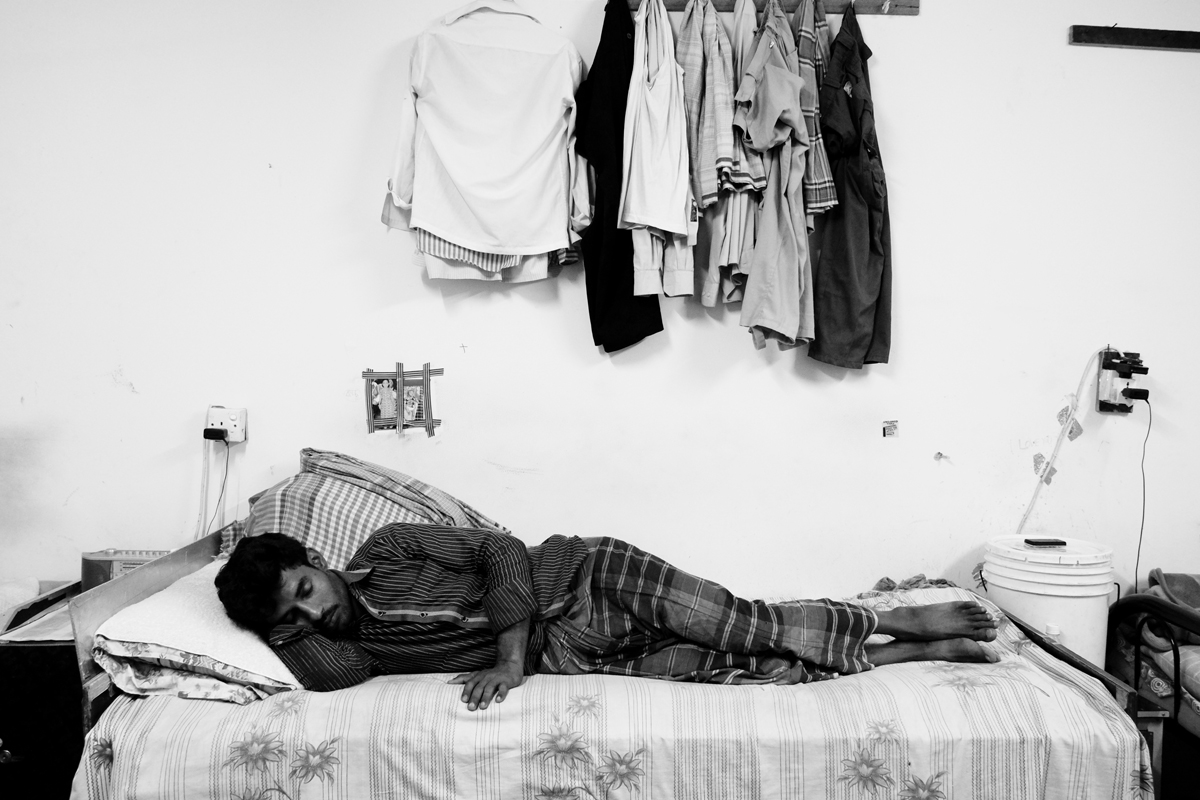
Paul: At the Toronto Film Festival in 2015, you spoke with the critic Dennis Lim. At one point, you discussed a commission for the Sharjah Art Foundation and your experience being in the United Arab Emirates for the first time and trying to figure out what to make. You wound up producing a video installation entitled Dilbar (2013) that’s in part a portrait of a Bangladeshi construction worker you met there.
Apichatpong: At that time, the foundation was building a new contemporary art museum and I was really struck by this neutral space for art. It’s the same everywhere, all over the world. It’s supposed to be a place to host art and all these different voices. So, I thought these construction workers are also part of the voices that should be included. It really started out of my personal curiosity about Dilbar’s family and where he came from. I just started talking to him. I was like a kid following my instincts. The process of making a film matters more to me than the work itself. That’s why I try to make the process part of the work. In this case, it was a discovery of a new friendship.
…it’s also an excuse to be away from Bangkok, a city that I cannot get used to…
Paul: It’s an aspect of your work that I’ve always found inspiring, how you integrate friendship into the filmmaking process. From the beginning, you’ve always welcomed different forms of collaboration. In Malee and the Boy (1999), you gave a microphone to a ten-year-old boy who roamed around Bangkok recording sounds while you created images separately. Together, they formed a kind of joint diary. Mysterious Object at Noon (2000), your first feature film, is organized around a series of encounters with everyday people who tell personal stories and fragments of stories that you piece together into a larger narrative.
Apichatpong: Filmmaking is almost like an excuse to go out into the world, because I’m naturally a really shy person. And it’s also an excuse to be away from Bangkok, a city that I cannot get used to. With the camera, I can be anywhere. It’s like a pretext. At the same time, it allows me to connect and build a new group or family. I always work with the same crewmembers, and it’s such a joy to grow old together with this medium of film as a link connecting us. It’s not only about work but about sharing different aspects of life – beliefs, political views, all these things that are always changing. And this affects the work. It’s not only about being on set working but about spending time together. I really try to embrace these chances. So, sometimes making a film is really just an excuse.
Paul: Friendship is an important theme in all of your films. You often show us different or unconventional friendships. Sometimes, we’re not always sure what the nature of the relationship might be, but this sense of openness and possibility is very special. It’s both inter-personal and political. I see friendship as a framework that you use to explore different aspects of intimacy, attraction and memory. One friendship central to your cinema is with the actress Jenjira Pongpas.
Apichatpong: For me, she was a link to a memory of the northeast land. I grew up more privileged than her. I was from a doctor family and there was a lot of history and information I just didn’t have. She grew up near the border and struggled a lot. I learned from her, trying to piece together bits of information she gave me to make sense of what happened in this part of the country. She became a friend and a teacher. I feel that I use her image in my films, so I need her. And she needs me, too, perhaps as a tool to communicate. In 2003, she had a motorcycle accident. She was riding a Harley-Davidson. She used to be a biker with black leather jackets. After the accident, she changed. I feel responsible for her body, actually. For example, when she went to the hospital for her leg operation, I almost felt like it was happening to my body and felt that I needed to be there. After Cemetery of Splendor, she had another operation. She spent a month in the hospital with her leg hoisted up by the weights on the other side and it’s really painful. She’s a fighter.
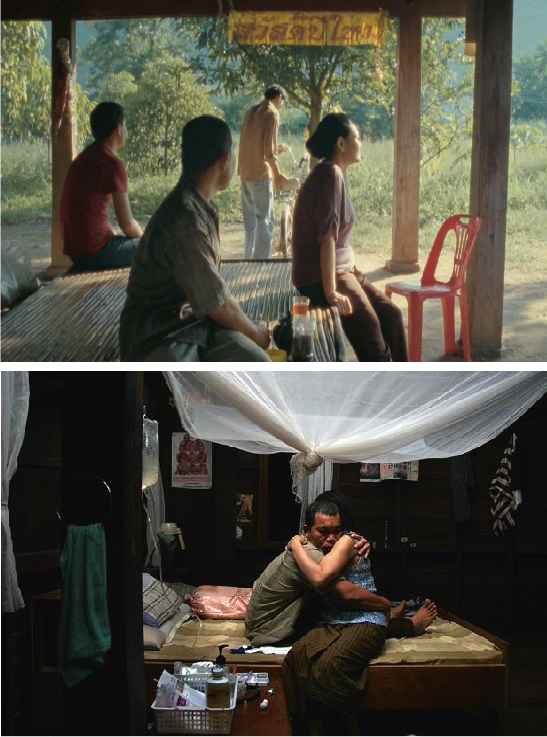
In the surrealist film, Uncle Boonmee Who Can Recall His Past Lives, Apichatpong Weerasethakul explores the concept of reincarnation against the haunting backdrop of his home country. The film follows the last days in the life of its titular character, who is dying of kidney failure on his farm. Boonmee is joined by his sister-in-law and nephew, who tend to him on his deathbed. The surrealist nature of the film is soon revealed, as the ghosts of Boonmee’s dead wife and son arrive at the farm one night. His son appears in the form of a bizarre ghost monkey with piercing red eyes, as if Chewbacca had been conceived in John Carpenter’s nightmare. The film then jumps between Boonmee’s final days and his past incarnations as, among other creatures, a water buffalo and a catfish. The two-hour film is like taking a journey to the jungles of Southeast Asia and beyond, into the consciousness of the director himself. Though he adopted the material from a book of a similar name, Weerasethakul freely admits that the story and images are largely based on his memories and experiences. Boonmee’s death from kidney failure is a retelling of how the director’s father passed away.
Paul: You and I both studied filmmaking under Shellie Flemming at the School of the Art Institute of Chicago. While there, she introduced me to the work of experimental filmmaker Bruce Baillie. He’s been a very important figure for you personally. All My Life (1966) may be his most well-known film. It’s a single three-minute pan across a white picket fence with flowers. The shot lasts exactly as long as the Billie Holliday song that you hear on the soundtrack. It’s simple and unforgettable. I feel there’s a spiritual quality connecting his work and yours.
Apichatpong: He’s important to me because his approach to filmmaking is not intellectual. It’s spiritual and instinctive. He approached filmmaking with shy curiosity at a time [in the sixties and seventies] when there was a lot of theory going on and a lot of formal experimentation. Bruce really embraced film in a kind of primitive way. He looked at it like alchemy. He was really involved in film processing and all these chemical interventions. I think it’s the root of filmmaking, when you just play with light and chemicals. You can see the love and gentleness in his work. At the same time, you can see the rebelliousness. He destroyed the rules of time and continuity. And also, his films are all quite funny.
Paul: I actually saw you and Bruce in conversation in New York in 2011. It was at the New Museum, when Primitive was exhibited there. You gave a four-hour masterclass one day, and I asked you to sign my book afterward. But you also arranged a screening of Bruce’s Quick Billy (1967–70), probably his seminal film, and held a discussion afterwards. Bruce, who was eighty at the time, had travelled from his home on a remote island off the coast of Washington State. It was quite a feat to bring him all the way to New York.
Apichatpong: Yes, it was very special. We still keep in touch. At that time, it was a very important moment for him because he was starting to use a new medium, which is digital video. I think he has just finished a new work that I haven’t seen yet. But I’m glad that I’m part of this history.
Paul: Light is an important theme in his films and in yours. For Bruce, moving from celluloid to digital is a big change, but you have always shuttled between film and video. Uncle Boonmee Who Can Recall His Past Lives (2010), however, was the last of your features to be shot on film, in this case on 16mm. Cemetery of Splendor (2015), by contrast, was shot with a high-end digital camera. I wondered whether the adoption of digital technology has affected your relationship to light.
Apichatpong: It used to. I remember feeling sad about this shift, lamenting the absence of the film grain and all of this. At the same time, when I thought about it, it just seemed like this silly attachment. It’s just what our eyes are used to. My young nephew’s eyes naturally have a different attachment. He has no relationship to celluloid. So why should I? I feel that it’s superficial: we just think about the ‘looks’. But we are still the same, and the rules are still the same. We still have to work with framing and storytelling. So, shifting to digital is not such a big deal. For me, virtual reality is a much bigger deal because it actually destroys the frame. It’s more promising, or more worrying. I don’t know. I think it shifts the definition of film and moves us closer to dreams, which I’m very infatuated with. Cinema tries to mimic dreams and their logic, the way we experience this light in the darkness. But in dreams, we are actually able to move and look around, whereas in cinema, we cannot. With VR, we start to get closer to dreams.
…the need to be in the dark and to lose oneself
I don’t drink alcohol, but I think that when people are intoxicated, it’s probably a similar experience…
Paul: During the talk in Toronto, you also showed a short video shot on a mobile phone of your boyfriend sleeping quietly in bed. You were filming him asleep, so he wasn’t aware of the camera. It was intimate, sweet and erotic. It made me think about how vulnerable people are when they’re asleep. I mention the video because sleeping is a recurring motif in your work. It has particular significance in Cemetery of Splendor, where a sleeping epidemic has taken hold of a group of ex-soldiers, whose dreams are haunted by past spirits.
Apichatpong: Well, my boyfriend likes to sleep, so I thought, ‘Let’s shoot this.’ It’s a game to see if the presence of the camera has some kind of energy to wake him up. But it goes back a long time in my work. Even in Dilbar, you see images of the construction workers sleeping. I think dreams are really important as a means of escape, and to discover a new reality. It’s a way for us to process information. It’s similar to the way we need movies – the need to be in the dark and to lose oneself. I don’t drink alcohol, but I think that when people are intoxicated, it’s probably a similar experience. It’s about trying to free yourself in some way. For me, dreaming is my way of drinking. I always look forward to sleep!
Paul: Sleeping also functions as a self-healing process. You’ve been exploring themes of medicine and healing for a long time as well. The romantic drama Blissfully Yours (2002) follows a young Burmese refugee suffering from a skin rash; Syndromes and a Century (2006) is a modernist sci-fi drama set entirely within two hospitals; Uncle Boonmee Who Can Recall His Past Lives (2010) is a supernatural tale about a man suffering from kidney failure; and Cemetery of Splendor mixes sci-fi and ghost stories and is set in a makeshift clinic for sleeping soldiers. Your parents were doctors and I read that you actually used their offices for the examination scenes in Blissfully Yours and Syndromes and a Century.
Apichatpong: Yes, I grew up in that environment of hospitals and clinics, which I really love, where all these people come and go with different problems. I’m always fascinated by medicine. I, myself, have been subject to many medicines, almost like a guinea pig for my parents. We think that we have problems when we’re sick, but in fact it’s so normal. If you don’t get sick, I think that’s a problem too! So, medicine is a big part of our life that is, perhaps, underrepresented in cinema. Especially now, we’re popping a lot of pills and supplements. I think that every film I make is about people trying to get better, in one way or another – through medicine, through exercise, through love. There are no ‘good’ or ‘bad’ people in my movies. No villains. But it’s all about people trying to retain memories and to get better.
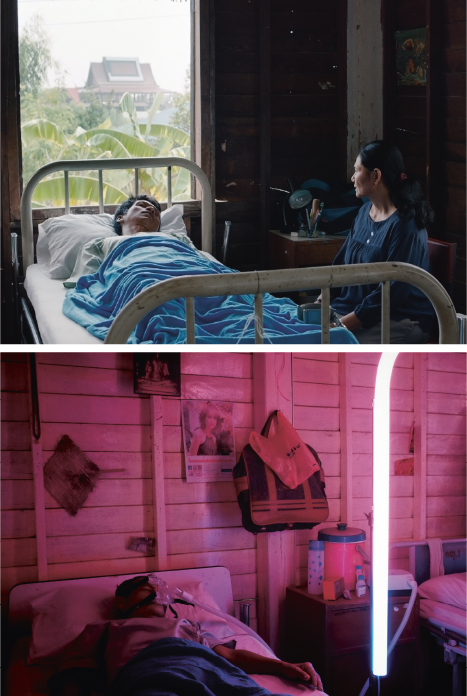
Soldiers with a mysterious sleeping sickness are transferred to a temporary clinic in a former school. The memory-filled space becomes a revelatory world for housewife and volunteer Jenjira, as she watches over Itt, a handsome soldier with no family visitors. Jen befriends young medium Keng who uses her psychic powers to help loved ones communicate with the comatose men. Doctors explore ways, including coloured light therapy, to ease the men’s troubled dreams. Jen discovers Itt’s cryptic notebook of strange writings and blueprint sketches. There may be a connection between the soldiers’ enigmatic syndrome
and the mythic ancient site that lies beneath the clinic. Magic, healing, romance and dreams are all part of Jen’s tender path
to a deeper awareness of herself and the world around her.
Paul: Touch as a form of therapy is also something we see in your films. Often it’s sensual, bordering on erotic. In Blissfully Yours, Jenjira’s character makes and applies a mysterious cream to a young man’s body that she says will heal his painful rashes. She’s also attracted to him and jealous of his young girlfriend. Thirteen years later in Cemetery of Splendor, we again see her character caring for a beautiful man. This time, it’s a somnambulant soldier played by the handsome Banlop Lomnoi from Tropical Malady. There’s an especially erotic scene where she applies cream to his naked torso while he sleeps.
Apichatpong: We used the same cream. It’s the same formula, actually! Because I work with the same crew and use the same actors in my films, I thought, ‘Why not use the same cream?’ For me, the skin cream is really about communication and about contact. In Blissfully Yours, Jenjira and Min’s girlfriend communicate in different ways to one another and to Min, who, as a Burmese immigrant, is someone who cannot speak their language. So touching and healing is one way.
Paul: I always assumed that Tropical Malady is about lovesickness. In the film, we see the same pair of young lovers in two different scenarios. The first is a contemporary gay romance that’s very tender, while the second recasts the men as hunter and creature in a supernatural fable. Syndromes and a Century is about a couple and the film is similarly divided into two parts, with the first part taking place in the sixties at a rural clinic, and the second unfolding in a contemporary hospital in Bangkok. I was particularly drawn to some of the startling imagery that punctuates that film, like the surreal lunar eclipse.
Apichatpong: I didn’t know during the shooting or even in the editing that there was this circle motif happening in the movie. At the beginning of the film, the woman asks the young doctor in the interview what shape he prefers and he says the circle. Later, there’s the solar eclipse and in the film’s second half, a long shot of a mysterious circular vent. When I was growing up, science fiction was really popular. We had translations of Arthur C. Clarke and Ray Bradbury, these giants. And for me, living in a small town, it was really attractive, this idea of space and different worlds. It synchronized with all these ghost stories and supernatural folktales of the region that I loved. These ancient tales and these future tales might seem like opposite poles, but for me they’re actually very similar.
Paul: You seem to combine the two inspirations in Uncle Boonmee Who Can Recall His Past Lives. I read that prior to making it, you had plans to make a big science fiction movie.
Apichatpong: Yes. The name of the film was Utopia. That’s what we’re all after, in terms of creativity and freedom. But somehow, everywhere seems to be heading in the opposite direction politically. I still want to make the movie, but I need to rewrite it. It’s an ecological science fiction disaster movie, and it’s about nature erupting, almost alive, and undergoing this cycle of change in the Western world. I don’t want to make it sound negative, but for me, I’m not so excited when I travel to the West. Whereas, when I travel to the East, I always discover new things from its history and stories. The movie is really about the West in crisis trying to reinvent itself. I planned to make it in the US because that’s where all my science fiction memories originate. I used to be so inspired by the science fiction books and movies from the seventies but I just don’t find inspiration in new work there now.
Paul: When we last met in 2015, we talked about your video installation Fireworks (Archive) and how it explored relationships between light and political memory. I’ve often thought of your films and videos collectively as a kind of archive for memories that would otherwise be lost, forgotten, or simply edited out of history.
Apichatpong: I’m really interested in perception and what we claim to be reality. Especially for a filmmaker, who always creates illusions or relies on lies to sculpt the world. I’m trying to question myself or to activate memories that don’t exist except through word of mouth, shared by people who were political victims. In Thailand and many other places, there are no documents. There is only propaganda. At the same time, my work is personal and very abstract. It’s not documentation. It’s not even historical record. It’s more about my personal reaction to a particular situation or place.
Paul: In 2014, a military coup seized power in Thailand and the country has been gripped by uncertainty under an increasingly oppressive dictatorship. I’m wondering how this is affecting you personally.
Apichatpong: The political situation now in Thailand is really extreme. It’s like a loop with the recent coup d’état: sometimes you have freedom and sometimes you don’t. Right now, we don’t. I just feel that I should step out for a bit and come back when I don’t have to censor myself. That’s why I’m planning to make my next movie in South America. I’m able to write and make short films here, but my feature films are really about storytelling and I would have to censor myself if I were to try to make one here right now. I am not an activist. I’m not Ai Weiwei. I’m not really aiming for my work to change the world. But I feel my own creativity is threatened here. There are so many situations that would surprise you. Like this morning, a student was arrested just because he shared a BBC news story online about the new king. The fact that he just clicked ‘share’ and the police came and arrested him is really brutal.
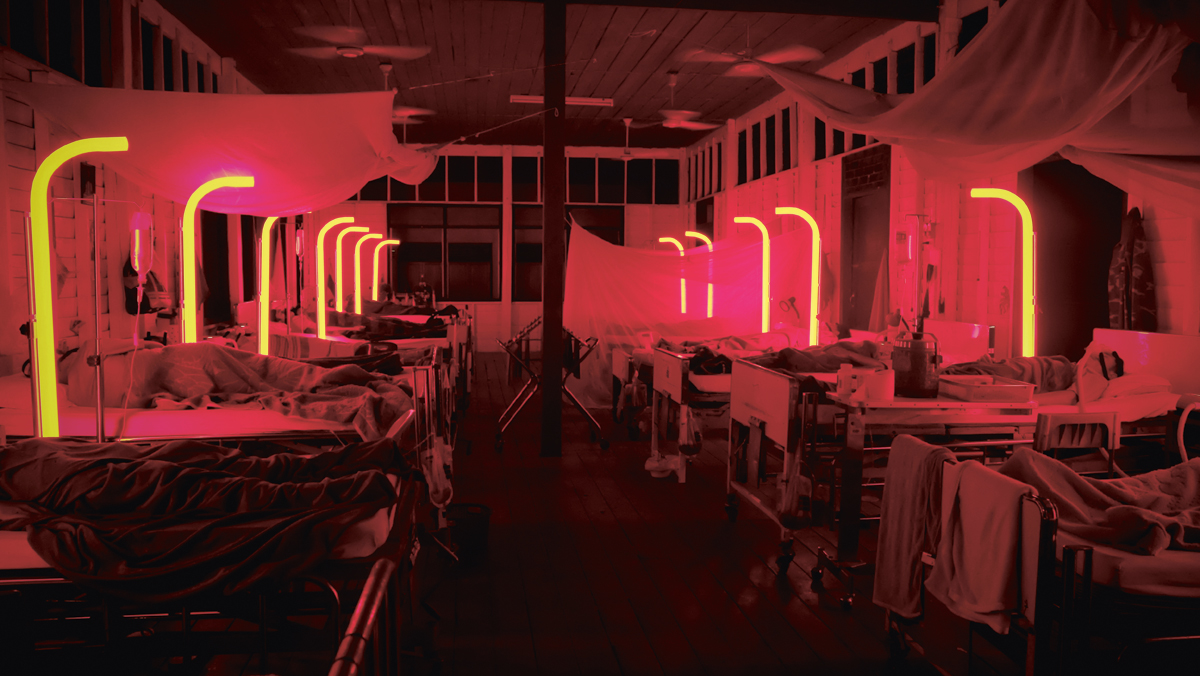
Cemetery of Splendor 2015, Courtesy film stills: Kick the Machine Films, Bangkok
Paul: After winning the Palm d’Or, did you find that your position changed at all in Thailand?
Apichatpong: It’s changed, but I really don’t pay attention to it. For me, what’s valuable about that experience is the ability to connect with different lives abroad. To reconnect the root, actually. Because when you think about science fiction or all these jungle adventure tales that influenced me when I was young, they have many origins outside of Thailand. They are from writers in the US and Europe who, through colonialism, romanticized places like the Amazon. Later, Thai writers copied these writers. All of these connections inspire me to expand my filmmaking.